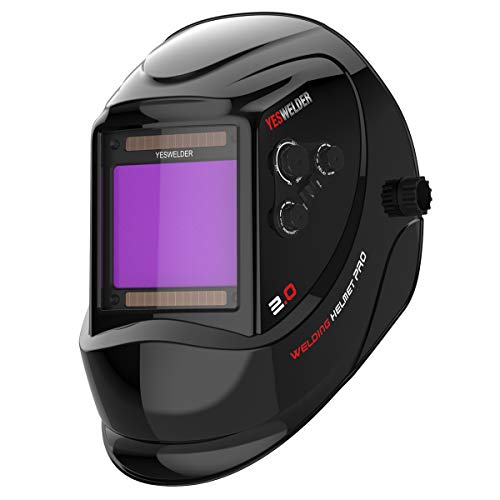Changing welding helmet batteries might seem challenging, but with knowledge and practice, the task can become much more manageable. Here are the details.
So, how do you change the battery in your welding helmet? Here are the necessary steps:
- Ensure that the batteries need to be changed;
- Keep the required items for battery replacement;
- Cut out plastic parts after locating the batteries;
- Replace old batteries with new ones and secure them in place
- Test the welding helmet
The full details of these steps have been explained below so that you can understand the process better.
Auto-darkening welding helmets
An auto-darkening helmet is an essential component of welding safety equipment. It can help increase your productivity since you won’t have to take off the helmet to view the results of the welding process.
It also works automatically to adjust light intensity to the right level so that you can see clearly.
Most auto-darkening welding helmets are powered by batteries, which means you may have to change the batteries from time to time as they get depleted.
Changing batteries is an important skill to have as a welding professional.
You should be able to change the helmet’s battery quickly without allowing it to affect your productivity.
Keep in mind that the battery change for your auto-darkening welding helmet is not as painful as it appears, especially to beginners.
Here are the simple steps that you can follow to change batteries with minimum hassle.
Be certain that the batteries need replacement
Replacing batteries can be time-consuming to some extent and even expensive. So it is necessary to ensure that your batteries do need to be changed.
You can take the following steps to be sure that a battery change is warranted.
Check alert
Certain high-end welding helmets emit a light signal to indicate a battery change.
You can, therefore, be quickly alerted whenever your batteries are running low.
This feature is now increasingly common in the newer auto-darkening welding helmets.
You should take a close look at your welding helmet as well as a user manual to make sure that this feature is available in your helmet model.
Use different intensities for welding
Depending on the ambient light levels of your welding helmet, it will automatically darken or become lighter. So if your auto-darkening helmet is not adjusting the light level correctly, it means that the batteries are weak.
You can test the batteries by carrying out welding at different intensities.
Start by welding under conditions such that the process generates plenty of sparks. If the light intensity is too bright, it implies that the auto-darkening function is not working well. You will have to change the batteries.
Outdoor sun test
No, you should not look towards the sun directly…
Instead, you should don the welding helmet and face the sun. Be careful as this can strain your eyes. Then, try waving your hands back and forth across the welding helmet.
The point here is to intermittently block the sunlight to check how the welding helmet is responding.
If your welding helmet is not responding quickly enough, then you won’t notice much change in the intensity of the light reaching your eyes.
If this indeed is the case, you will have to replace the batteries.
Gather required items
Before going into the details, you should realize that although there are specific guidelines applicable to all welding helmets.
There may also be specific instructions for your welding helmet make and model. So make sure that you read the user manual that came with your auto-darkening welding helmet.
Here are the items that are most often required by most welding helmet types:
- Strong glue, for instance, hot glue
- Dremel tool
- One screwdriver
- Four batteries (these may be AA or AAA)
- Soldering iron
- Cell holders to keep the batteries in place. 3VDC cell holders are a common choice
Locate batteries
Once all the necessary materials are in place, you should then proceed to find the battery location on your welding helmet.
Batteries are often installed on the front side of the casing.
While checking the front casing part close to the lens, you may notice a solar cell. You might be tempted to think that the purpose of the solar cell is to power the helmet when working outdoors under the sun.
However, the solar cell is used for different purposes in most auto-darkening welding helmets.
This part of the lens casing contains photo sensors that detect ultraviolet light levels, which impact the darkness level.
After locating this region, dissect the battery with the help of your Dremel tool. One of the best methods for dissecting your batteries is the Riemann sum grinding process.
Cut out the plastic part
After locating the battery, you should proceed to cut the plastic area to extract it.
This region is about as big as a stamp.
Begin by keeping the helmet on the table for support and stability. Cut the postage-sized square plastic piece while making sure that it is not too deep.
After cutting, a plastic piece will be removed.
Do not dispose of this plastic piece.
You should keep it where it can easily be found since you will have to use it again.
The battery will now be visible. You will notice the polarities as well as the lead locations for the battery.
Keep in mind the site of the battery and note the polarity so that you can install the new battery correctly.
Take out the battery
This step requires the most care…
Notice the tabs that are holding the battery securely in position. You can loosen these tabs using a screwdriver with very thin blades or precision nippers.
This step will allow you to remove the old battery and replace it with the new one.
While working the tabs, make sure that you handle them with the right level of force so that these essential parts do not break.
You may need to apply a specific force to pry these tabs open without allowing them to break free from the PCB to which they are connected.
Take your time and make sure that you get this step right.
After the tabs have become loose, you can remove the battery.
Replace with the new battery
After you have taken out the old battery, use the solder to join the battery holder and leads with the new battery.
Connect the read lead with the positive side and the black lead with the negative side. When you have connected the leads, cut out a small incision to make a slot.
This way, the wires can run externally to connect with the rest of the helmet.
Keep the battery in the battery holder and start going through the processes mentioned above in reverse to reconstruct the helmet.
Keep the battery holder in the same position as the original battery and use your adhesive of choice to glue back everything in place.
Remember to put back the plastic cutout and the wires.
Second new battery
With a fair amount of practice, you will be able to replicate this procedure without too many problems.
If you feel the previous steps were not too hard, then that is a good thing because you will have to repeat the same steps the same way for the second battery.
The second battery is often positioned on the other side of the first battery. You will have to look at the other side of the welding helmet and begin grinding.
For this battery, you can follow the steps outlined above for the first battery.
Remember to join the red lead with positive polarity and the black lead with negative polarity.
Cutting the small slot behind the LCD case is also a good idea so that the holder leads can be routed easily.
The two batteries serve two distinct purposes.
- The first battery is used to provide power for analog circuits that process the optimum light intensity.
- The second battery regulates the lens voltage, which determines the level of darkness.
Testing
After you have securely installed the two batteries, you will need to put your welding helmet to the test. This way, you can verify that it is working correctly.
There are several ways to test if the batteries are working fine. The most convenient way to check for this is to carry out the sun testing procedure mentioned above.
You can glance at the sun while wearing the welding helmet and then wave your hand in front of your eyes.
The auto-darkening function responds quickly when the batteries are correctly installed and working fine.
Welding helmets from the past used to be rather crude devices that had to be lifted continuously to check welding progress since they lacked an auto-darkening function.
The latest welding helmets often have this feature, which works via an auto-darkening filter lens.
For continued access to this high-tech feature, you should know how to change the battery in your welding helmet.
Do welding helmets need batteries?
For those unfamiliar with auto welding helmets, you ought to be aware that a range of welding helmets are constructed using stationary inner batteries, which may be replaced, typically aided with a solar panel. They are inclined to require charging in sunlight before use and following prolonged stored intervals.
Do auto-darkening welding helmets have batteries?
It’s a common belief that auto-darkening welding helmets are required to possess a power supply to have the ability to operate on account of the auto-darkening technologies that trigger the ADF. There are two main ways producers electricity their welding helmets, utilizing either batteries or solar power.
What kind of battery does a Miller Elite Welding Helmet take?
The Miller Elite auto-darkening welding helmet takes a Lithium CR2450 battery. Elite & Digital Elite versions of this auto-darkening helmet will need two of these.


